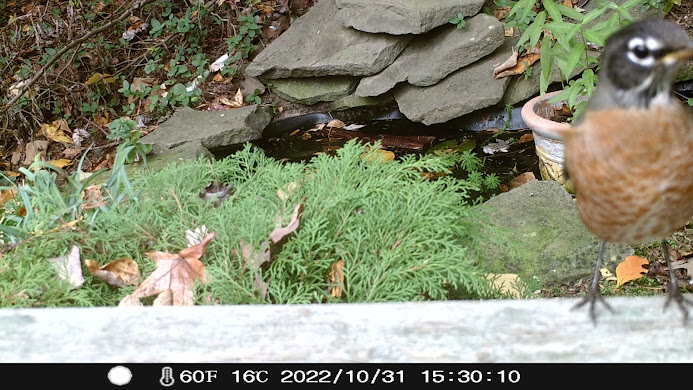Bogturtle's Garden - November 1 to 15, 2022
Robin takes a selfie. Not part of the amazing hundreds in the flocks that swing, periodically, all Winter, through the property, mainly eating the Holly Berries.
To my surprise, yesterday, a little frog was sitting on the piece of floating cedar Today,11/1, is quite a warm day, so wintering in the mud may come later.
To the left, the Fothergilla 'Mt Airy' does, usually, turn this yellow, being in a good deal of shade.
Groundhogs are no longer tolerated on this property, as several different crops from the garden were decimated. Even those where they can sneak, somehow, into the fenced off area. A total loss, really. So two were trapped and carried away. Then, yesterday, I saw one at the bird feeder, eating dropped seed. I set the trap there, thinking I would waste time, catching the constant squirrels with the pieces of apple Groundhogs find so inviting. But last night this Possum, many visiting constantly, got trapped. Only a menace if cornered, so I opened the trap and left. Will bait the trap again, and I hope this individual has enough intelligence to not get trapped again, but I have my doubts about that. The animals are so well known as not too bright. Amazing that they are still common.
Viburnum 'Popcorn'.
Hydrangea quercifolia 'Snow Queen'. The classic form of the Oakleaf Hydrangea, a native somewhere south of NJ.
These flowers were caught by the Sun and photographed through the branches of Cornus officianalis, the Japanese Cornel. That has colored nicely with reddish leaves.
Squirrel takes a selfie. Just seems really funny. Nobody wastes more battery power than these, but worse was that one who took 18 bite sized pieces, all over, out of this bench when I first put it there. Filled in and stained with the same silvery driftwood stain chosen for the house, you would not notice the damage now. That is still not funny.
This is the colored bark Dogwood or Cornus. C. sanguinea 'Winter Fire'. Too vigorous, it is moved to where it cannot easily send out suckers and become a grove, which it is so prone to do. Beautiful yellow to red winter bark and the typical white flowers, in Spring, that lack the large, showy bracts that make the most common Dogwoods so attractive. Those are, likely, Cornus florida or Kousa. This will have just a button or boss of little flowers, typical of all the colored bark Dogwoods of many species. Quite showy, at the moment, and the reddish to yellow little twigs can just about be seen in the photo. A trio of large Witch-Hazels back the shrub, so it has trouble spreading in among them, though it will. And I make sure it doesn't move into the lawn.
















.JPG)


Comments
Post a Comment